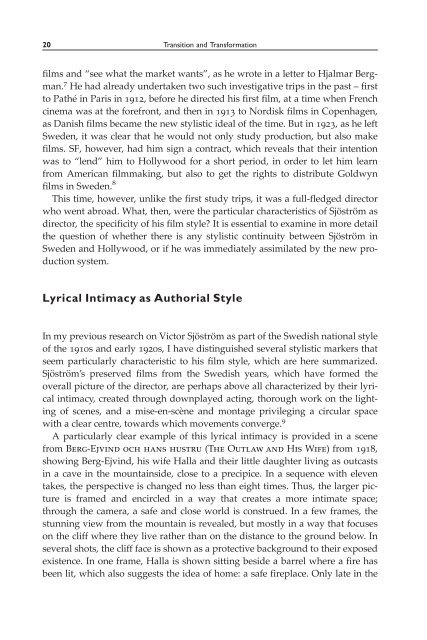FILM FILM - University of Macau Library
FILM FILM - University of Macau Library
FILM FILM - University of Macau Library
Create successful ePaper yourself
Turn your PDF publications into a flip-book with our unique Google optimized e-Paper software.
20 Transition and Transformation<br />
films and “see what the market wants”, as he wrote in a letter to Hjalmar Bergman.<br />
7 He had already undertaken two such investigative trips in the past – first<br />
to Pathé in Paris in 1912, before he directed his first film, at a time when French<br />
cinema was at the forefront, and then in 1913 to Nordisk films in Copenhagen,<br />
as Danish films became the new stylistic ideal <strong>of</strong> the time. But in 1923, as he left<br />
Sweden, it was clear that he would not only study production, but also make<br />
films. SF, however, had him sign a contract, which reveals that their intention<br />
was to “lend” him to Hollywood for a short period, in order to let him learn<br />
from American filmmaking, but also to get the rights to distribute Goldwyn<br />
films in Sweden. 8<br />
This time, however, unlike the first study trips, it was a full-fledged director<br />
who went abroad. What, then, were the particular characteristics <strong>of</strong> Sjöström as<br />
director, the specificity <strong>of</strong> his film style? It is essential to examine in more detail<br />
the question <strong>of</strong> whether there is any stylistic continuity between Sjöström in<br />
Sweden and Hollywood, or if he was immediately assimilated by the new production<br />
system.<br />
Lyrical Intimacy as Authorial Style<br />
In my previous research on Victor Sjöström as part <strong>of</strong> the Swedish national style<br />
<strong>of</strong> the 1910s and early 1920s, I have distinguished several stylistic markers that<br />
seem particularly characteristic to his film style, which are here summarized.<br />
Sjöström’s preserved films from the Swedish years, which have formed the<br />
overall picture <strong>of</strong> the director, are perhaps above all characterized by their lyrical<br />
intimacy, created through downplayed acting, thorough work on the lighting<br />
<strong>of</strong> scenes, and a mise-en-scène and montage privileging a circular space<br />
with a clear centre, towards which movements converge. 9<br />
A particularly clear example <strong>of</strong> this lyrical intimacy is provided in a scene<br />
from Berg-Ejvind och hans hustru (The Outlaw and His Wife) from 1918,<br />
showing Berg-Ejvind, his wife Halla and their little daughter living as outcasts<br />
in a cave in the mountainside, close to a precipice. In a sequence with eleven<br />
takes, the perspective is changed no less than eight times. Thus, the larger picture<br />
is framed and encircled in a way that creates a more intimate space;<br />
through the camera, a safe and close world is construed. In a few frames, the<br />
stunning view from the mountain is revealed, but mostly in a way that focuses<br />
on the cliff where they live rather than on the distance to the ground below. In<br />
several shots, the cliff face is shown as a protective background to their exposed<br />
existence. In one frame, Halla is shown sitting beside a barrel where a fire has<br />
been lit, which also suggests the idea <strong>of</strong> home: a safe fireplace. Only late in the

















